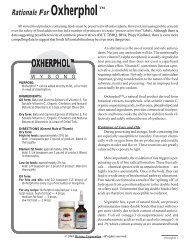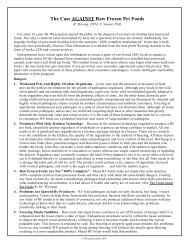Vitamin Basics DSM.pdf - Wysong
Vitamin Basics DSM.pdf - Wysong
Vitamin Basics DSM.pdf - Wysong
Create successful ePaper yourself
Turn your PDF publications into a flip-book with our unique Google optimized e-Paper software.
86IntroductionBiotin is a colorless, water-solublemember of the B-complex group ofvitamins. Although biotin was discoveredalready in 1901 as a specialgrowth factor for yeast, it took nearlyforty years of research to establishbiotin as a vitamin. Due to its beneficialeffects for hair, skin and nails,biotin is also known as the “beautyvitamin”. There are eight differentforms of biotin, but only one of them– D-biotin – occurs naturally and hasfull vitamin activity. Biotin can onlybe synthesised by bacteria, moulds,yeasts, algae, and by certain plantspecies.FunctionsBiotin plays a key role in the metabolismof lipids, proteins and carbohydrates.It acts as a critical coenzymeof four carboxylases(enzymes):• acetyl-CoA carboxylase (involvedin the synthesis of fatty acids fromacetate)• propionyl-CoA carboxylase (involvedin gluconeogenesis, i.e. thegeneration of glucose from lactate,glycerol, and amino acids)• -methylcrotonyl-CoA carboxylase(necessary for the metabolism ofleucin, an essential amino acid)• pyruvate carboxylase (involved inenergy metabolism, necessary forthe metabolism of amino acids,cholesterol, and odd chain fattyacids)Biotin also plays a special role inenabling the body to use blood glucoseas a major source of energy forbody fluids. Furthermore, biotin mayhave a role in DNA replication andtranscription arising from its interactionwith nuclear histone proteins. Itowes its reputation as the “beautyvitamin” to the fact that it activatesprotein/amino acid metabolism inthe hair roots and fingernail cells.Main functions in a nutshell:• Synthesis of fatty acids, aminoacids and glucose• Energy metabolism• Excretion of by-products fromprotein metabolism• Maintenance of healthy hair,toenails and fingernailsDietary sourcesBiotin is widely distributed in mostfoods but at very low levels comparedto other water-soluble vitamins.It is found in free and proteinboundforms in foods. Its richestsources are yeast, liver and kidney.Egg yolk, soybeans, nuts and cerealsare also good sources. 100 g ofliver contains approximately 100 µgbiotin, whereas most other meats,vegetables and fruits only containapproximately 1 µg biotin /100 g. Inanimal experiments, biotin bioavailabilityhas been shown to vary considerably(5%-62%), and in cereals itappears to be lower.Biotin content of foodsFoodBrewer’s yeast 115Beef liver 100Soya beans 60Wheat bran 45Peanuts 35Egg 25White mushrooms 16Spinach 6.9Bananas 6Strawberries 4Whole wheat bread 2Asparagus 2(Souci, Fachmann, Kraut)Biotin(µg/100g)Biotin-producing microorganismsexist in the large intestine, but theextent and significance of this enteralsynthesis in the overall biotinturnover is difficult to calculate andthus remains a subject of controversy.Absorption andbody storesIn most foodstuffs biotin is bound toproteins from which it is released inthe intestine by protein hydrolysisand a specific enzyme, biotinidase.Biotin is then absorbed unchangedin the upper part of the small intestineby an electron-neutral sodium(Na + ) gradient dependent carriermediatedprocess and also by slowpassive diffusion. The carrier is regulatedby the availability of biotin,with up-regulation of the number oftransporter molecules when biotin isdeficient. The colon is also able toabsorb biotin via an analogue transportmechanism. Once absorbed,biotin is distributed to all tissues.The presence of a specific biotincarrier protein in plasma is not yetconclusive. The liver and retinal tissuesare the main storage places.Biotin metabolites are not active asvitamins and are excreted in theurine. Remarkable amounts of biotinappear in the faeces deriving fromcolonic bacteria.MeasurementThe body status of biotin can bedetermined by measuring its activityand/or activation of biotin dependentenzymes – predominately carboxylases– by added biotin. Moreconvenient methods are directdetermination of biotin in plasma orserum by microbiological methodsor avidin binding assays, or determinationof biotin excretion and 3-hydroisovaleric acid in urine.Measurement of biotin in plasma isnot a reliable indicator of nutritional




